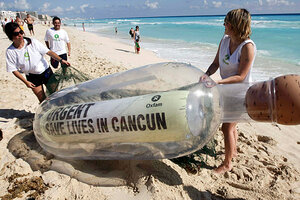Climate change talks in Cancun: What can be accomplished?
The two-week negotiations begin on Monday and carry far lower expectations than did last December's climate change talks in Copenhagen.

Oxfam actiists carry a giant bottle on the shores of a beach in Cancun on Nov. 28. The bottle contains a message reading 'Urgent: Save Lives in Cancun,' in reference to millions of the world's poorest people. Mexico will host international climate change talks among almost 200 nations meeting in Cancun from Nov. 29 to Dec. 10.
Reuters
Talks aimed at building a broad international alliance to fight global warming resumed in Cancun, Mexico, on Monday with modest expectations for progress – and from some climate-policy specialists, an acknowledgment that without movement on several key issues, a process that began 18 years ago with the Earth Summit in Rio de Janeiro may well have run its course.
The two-week, United Nations-sponsored negotiations, drawing delegates from nearly 200 countries, carry far lower expectations than did last December's tumultuous climate-change talks in Copenhagen, Demark.
"There is a need for progress at Cancun, but no one is expecting the final deal," says Robert Orr, the UN's assistant secretary-general for policy planning. "We need to remind ourselves that the climate challenge wasn't created overnight, and it won't be solved overnight."
That stands in stark contrast to last year's talks in Denmark. They were to have yielded a legally binding climate treaty that included the United States and developing countries, as well as a new enforcement period for industrial countries covered by the 1997 Kyoto Protocol – according to a timeline that negotiators signed off on two years earlier at talks in Bali, Indonesia.
Instead, Copenhagen resulted in a nonbinding, voluntary document – the Copenhagen Accord – cobbled together at the last minute by leaders of a handful of influential developed and developing countries.
By the UN's count, 140 nations have signed on to the accord and have included descriptions of actions they plan to take to either reduce their greenhouse-gas emissions or at least curb the rate of increase in emissions. Many of those actions, however, are conditional: They hinge on actions taken by other countries or, in the case of the US, on legislative action at home. A comprehensive energy and climate bill passed the US House. But the Senate didn't act because the Democratic majority couldn't ensure enough bipartisan support to pass its own version.
Even if everyone implemented their most stringent pledges rigorously, the world would be only 60 percent of the way toward the emissions levels that scientists say would be needed by 2020 to put countries on a path toward holding global warming to about 2 degrees C (3.6 degrees F.) by the end of this century, according to a recent analysis undertaken for the UN.
By the standard established in Bali, last year's accord could be seen as a failure, says Jonathan Lash, president of the World Resources Institute, an environmental-policy group in Washington. But, he adds, the Copenhagen Accord also could be seen as the foundation of an eventual, more complete agreement.
"Cancun is going to answer the question of whether that agreement was progress or the beginning of the end of the international process," he says.
Indeed, one item up for discussion is extension of the negotiating process itself.
The negotiating road map that delegates backed in Bali in 2007 envisioned a new agreement in two years. That negotiating mandate expired in Copenhagen, notes Andrew Deutz, a former policy adviser to the International Union for Conservation of Nature who now heads the Nature Conservancy's international climate-policy effort. Thus negotiators now have to set out a new road map.
Some examples of issues where progress is possible, several specialists say:
• Using forest conservation as a tool that developing countries can take up to reduce CO2 emissions. In exchange for "avoiding" deforestation, countries would earn emissions credits they can sell on international carbon markets. According to analysts, negotiators made good progress on the issue in Copenhagen, which could lead to an agreement that would give countries clear guidance on implementing the approach, known by its acronym REDD.
• Resolving issues related to the $30 billion that industrial countries pledged in so-called fast-start money over three years at Copenhagen. This money is to be used to help developing countries adapt to climate change, as well as afford greener technologies to slow their CO2 emissions. Some of the issues have to do with the makeup of the body that oversees the distribution of that money and the transparency that donors demand to ensure the money is well spent. By 2020, such aid is anticipated to reach $100 billion a year.
That still leaves three crucial issues whose resolution may be a year or two off, specialists add.
One involves transparency under the Copenhagen Accord – common accounting rules and easily monitored and verifiable actions for all pledging countries.
A second deals with the emissions goals that countries collectively are trying to achieve – a so-called "shared vision."
Finally, the legal form of any agreement is still up for grabs, along with decisions on whether the Kyoto Protocol and an agreement including those not covered by Kyoto stand as two separate pacts or are merged into one über agreement.
"I would call these the real crunch issues," says Jennifer Morgan, who heads the climate and energy program at the World Resources Institute.
